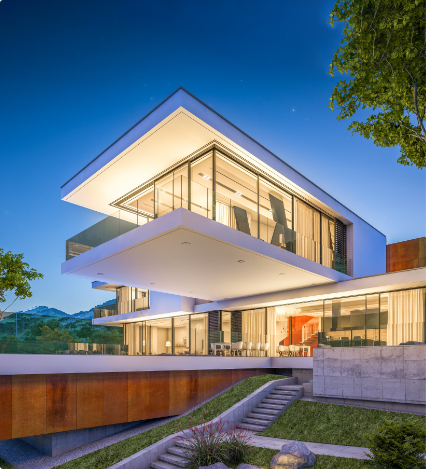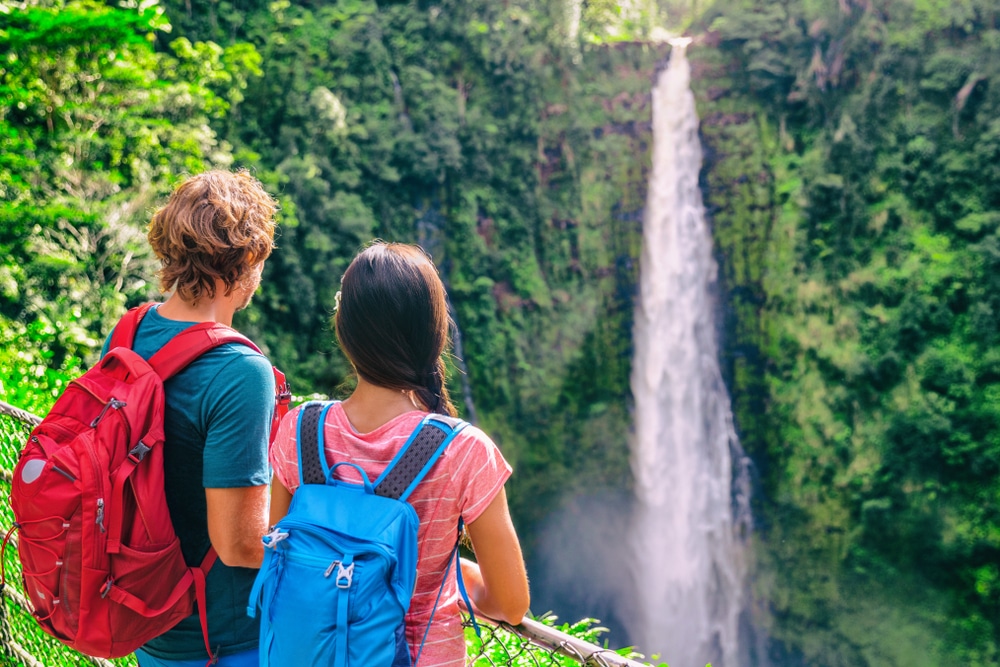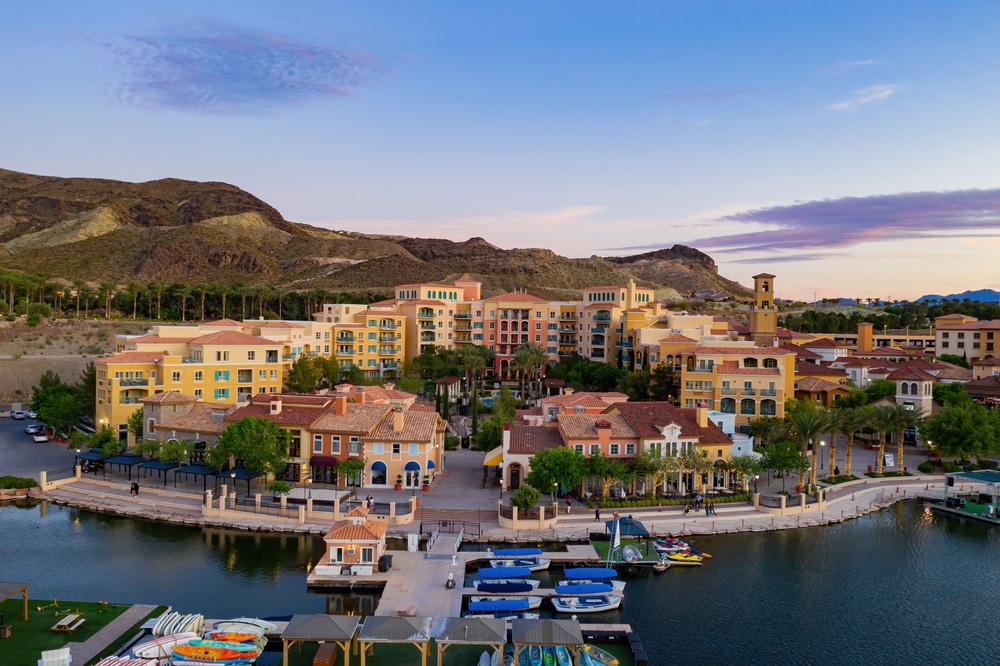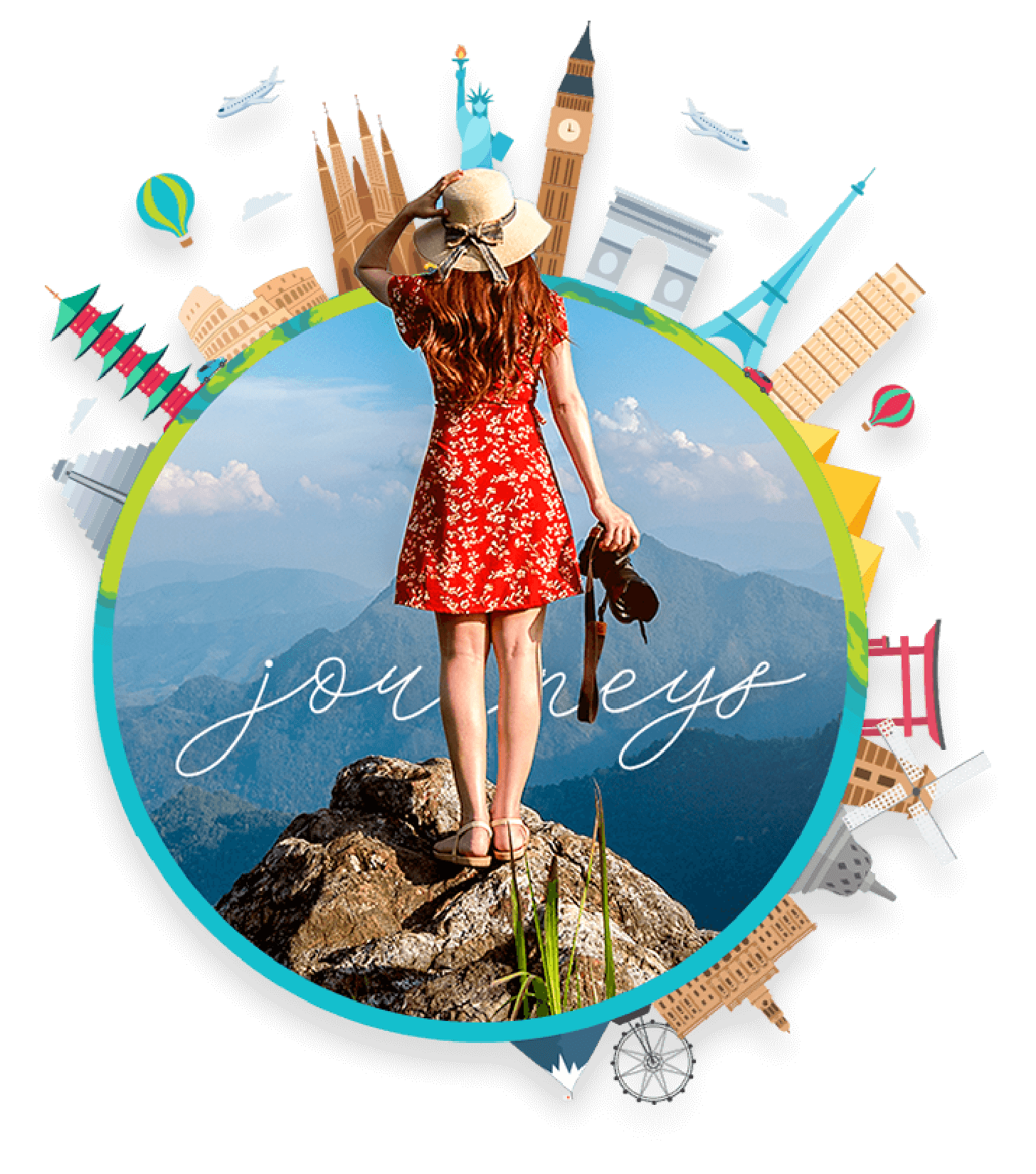The Big Island of Hawaii is the largest and youngest island in the Hawaiian chain. Due to ongoing volcanic activity, the Big Island is bigger than all other Hawaiian islands combined. It is the only Hawaiian island with active volcanoes, including Mauna Loa, the world’s largest, and Kilauea, the most active volcano on Earth.
The Big Island of Hawaii is divided into eight microclimates, including desert and arctic tundra. As a result, it has everything when it comes to diversity, including snow skiing, volcanoes, beautiful beaches, and tropical rainforests.
Narrowing Down Where to Stay
Compared to other Hawaiian islands, however, the Big Island has fewer beaches. Still, they are spectacular, with white, black, and even green sand dotting a coastline broken up by rugged cliffs, some of which have streams of lava spilling into the Pacific ocean.
With this in mind, it may be challenging to figure out where to stay on the Big Island and what activities you prefer to be closest to. So, allow us to do the heavy lifting. A week can be plenty of time on smaller islands like Kauai, Maui, or Oahu. However, the Big Island’s immensity necessitates more time to explore all the must-see sights.
The Hilo and Kona sides are the two main divisions of the island. Although both towns have airports (KOA for Kona and ITO for Hilo), Kona sees most of the arriving and departing flights.
We’ll go over what part of the island is best for families, couples, solo travelers, and those on a tight budget, as well as some of the greatest things to do, travel tips, and more!
Read on for the best areas to stay on the Big Island of Hawaii. Aloha!
Family-Friendly Areas on the Big Island of Hawaii
Kailua-Kona
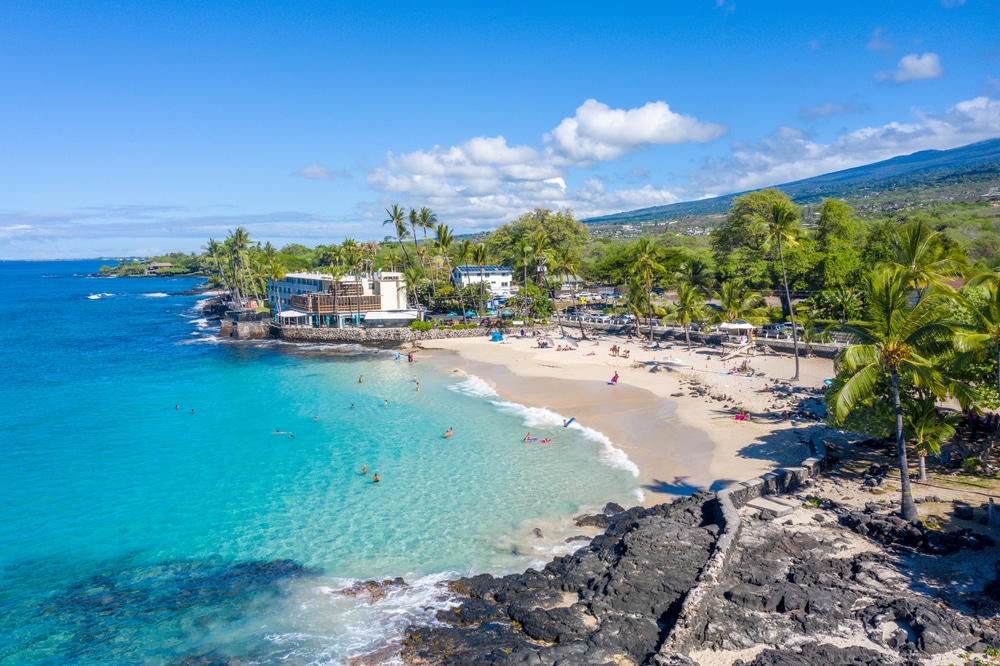
The town of Kailua-Kona (commonly referred to simply as “Kona”) broadly refers to the entire island’s west side. The Kona coast offers the ideal fusion of family-friendly lodgings and entertaining activities.
On this side of the island, which is mostly made up of lava fields as far as the eye can see, there are sadly no lush jungles or rainforests. However, the weather is warmer, and there is a lot of sunshine, along with the best hotels, resorts, condos, and the best beaches.
Not only is Kona the ideal area for families, but first-timers to the Big Island will also enjoy everything Kona town has to offer, including:
- Night snorkeling with manta rays: This is considered one of the most memorable dives in the world. All of the manta rays you encounter during the night dive are locals! Manta rays are a non-migratory species. They visit their feeding areas daily for dinner, meaning you can see them any time of year.
- Kaloko-Honokōhau National Park: This historical park is a stunning hiking location that houses a treasure of ancient Hawaiian history. It offers everything one might want to learn about prehistoric Hawaiian culture. This includes heiau (temple) ruins, fishponds, a fish trap, a canoe hale, rock art, a freshwater-fed Queen’s bath surrounded by enigmatic mounds, and spectacular petroglyph fields.
- Kamakahonu Beach: Other names for Kamakahonu are King Kam Beach and Kids’ Beach. The sandy beach’s calm seas and serene surroundings make it ideal for sunbathing and snorkeling. This beachside lagoon next to Kailua Bay is a well-liked vacation spot for families or anyone looking for a safe location to swim, launch a kayak, or use a paddleboard. The Hawaiian name Kamakahonu, “the turtle eye,” comes from a rock beneath Kailua Pier in the shape of a turtle.
- Keauhou Bay: King Kamehameha III was born in Keauhou Bay, on Kailua-Kona’s southern outskirts. This protected bay is home to an ancient warrior’s burial place and a sacred stone that is supposed to have resuscitated a stillborn king. Keauhou Bay is well known for its craggy sea caves and pristine ocean conditions. Discover the rich history, underwater paradise, and every inch of Keauhou Bay’s stunning environment.
Furthermore, “downtown” Kona features oceanfront shops and restaurants along with a few historical landmarks. Choose a great restaurant on the water to enjoy a refreshing Hawaiian cocktail and delectable regional fare during sunset.
Alternatively, dine at one of the numerous resorts and catch a luau that the whole family will enjoy. Finally, if you’re in the mood to shop, visit Kona’s main drag, Alii Drive, to peruse some trendy stores and people-watch to your heart’s content. And don’t forget to sample some world-renowned Kona coffee.
Waikoloa
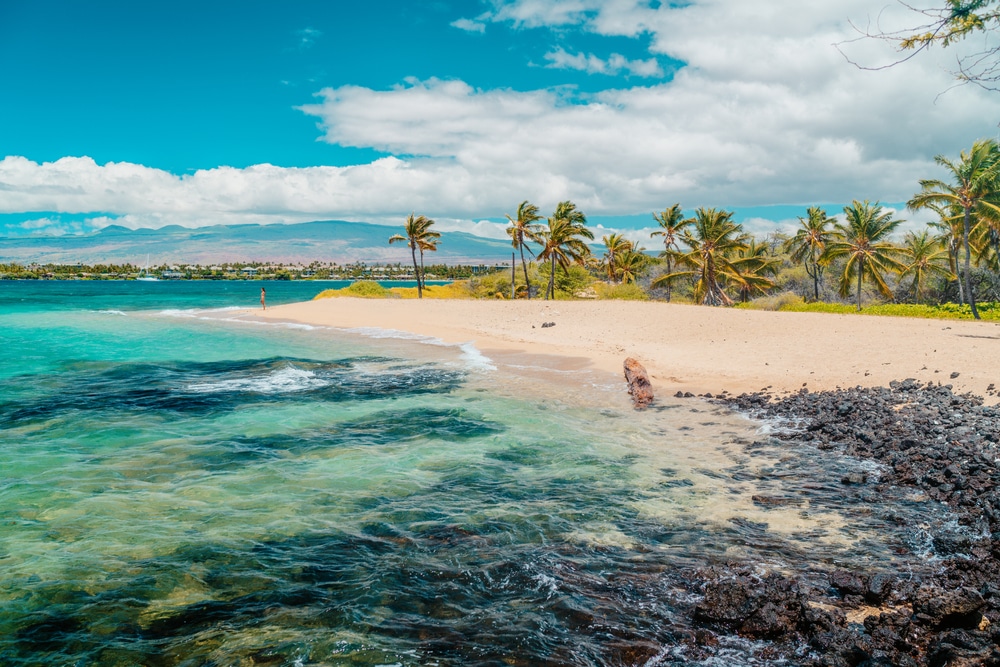
A brief drive north will take you from Kona to Waikoloa. The lovely resort town of Waikoloa is a completely kid-friendly area, offering maximum sunlight with only a small, welcomed amount of rainfall.
Stay along the western coastline, where you’ll find many beaches, swimming pools, waterslides, and family-friendly activities. Additionally, there are many different food options along the stretch of resorts in this region.
Anaehoomalu Bay’s (A-Bay) mild waters are perfect for swimming, snorkeling, scuba diving, and even windsurfing. Parents will find this to be the ideal place to unwind, sip tropical cocktails, soak up the sun, and cap the day with a spectacular sunset while the kids enjoy some shaved ice.
A fun-filled family day in Waikoloa starts here:
- Waikōloa Anchialine Pond Reservation Area: Located inside the Waikoloa Beach Marriott beach resort, this natural attraction comprises brackish water lava pools that tiny sea animals call home, including little red shrimp known as “micro-lobsters.” Within easy access for everyone, you can take the 5-minute trail from the roadside parking to get to the seashore. The ponds may appear to be a nice spot to swim, but that is not the case, as they are filled with spiky lava rock.
- Kalahuipua’a Historical Park: Along the trails of the Mauna Lani resort, explore the amazing petroglyphs, lava tube houses, and fishponds at this historical park. Fish for the royals used to be abundant in these ponds. Be sure to bring water, sun protection, and the proper hiking equipment. You can check out the shops at the resort after exploring the park.
- Waikoloa Dry Forest Initiative: Ancient wiliwili trees can be found in this dry forest. The initiative’s primary goal is to plant hundreds of trees every year to keep the species from going extinct because there are less than 100 left in the world. For people interested in learning more about conservation initiatives, the program offers a variety of volunteer opportunities, field trips, and guided walks. Guided treks are also available on the first Friday of every month at 5 PM.
Couples’ Favorite Areas on the Big Island of Hawaii
Kohala
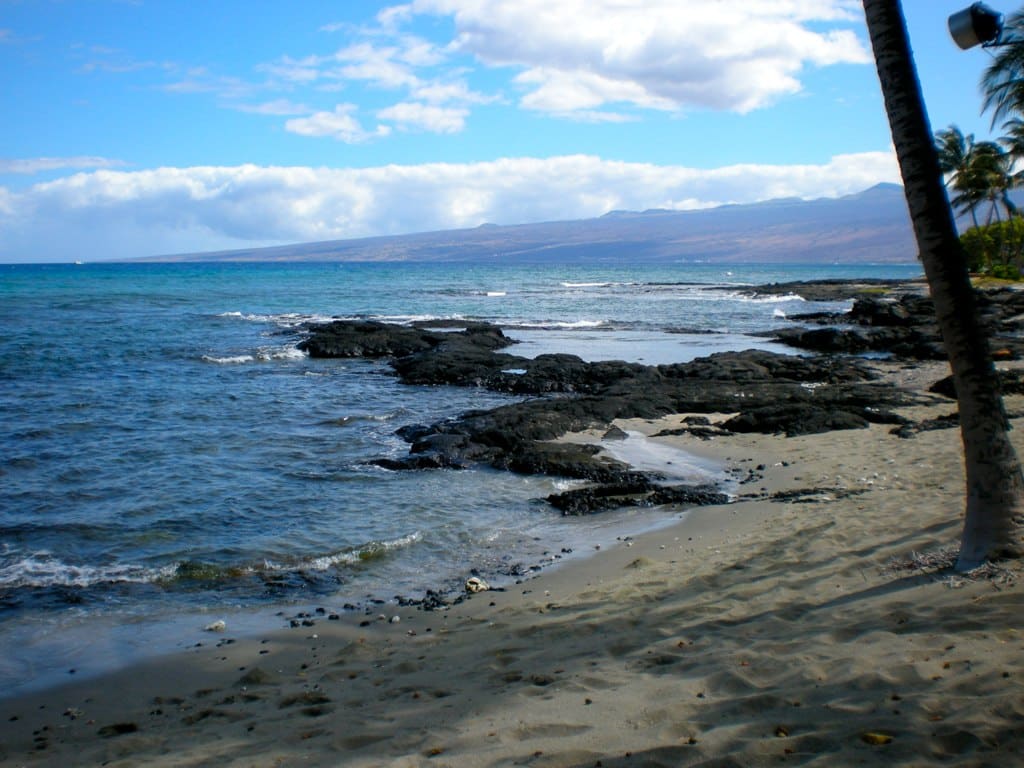
The island’s best beaches and most beautiful scenery can be found along the Kohala Coast, which is also the ideal location for snorkeling. You won’t have trouble deciding where to stay in Kohala because this is home to the most charming resort area, with white sand beaches.
The Kohala coast turns the romance up a notch with its many luxury hotels and resorts. You can sip a Hawaiian cocktail while lounging among swaying palms and admiring the ocean’s breathtaking blue hues. Think picture-postcard and Instagram-worth moments!
Below are some of the must-see and must-do Kohala attractions:
- Hāpuna Beach State Park: Hapuna Beach, the largest of the Big Island’s white sand beaches, is frequently ranked among the top 10 beaches in the world. Additionally, Hapuna routinely provides ideal swimming, bodyboarding, sunbathing, and snorkeling conditions. It’s also possible to see migrating whales during the earlier part of the year.
- Lapakahi State Historical Park: A sizable area of ancient Hawaiian fishing village ruins can be found in the North Kohala District’s Lapakahi State Historical Park. Along the 1-mile journey, there are numerous prehistoric buildings and relics, including various dwelling sites, canoe storage buildings, salt-making pans, kukui nut lampstands, and even a few kōnane games, which are similar to checkers.
- Awini Trail to the Honokāne Nui Lookout: Hikers can make use of the Awini Trail to visit Honokāne Nui, a spectacular valley, for even more scenic views. The moderately challenging trek, which frequently involves mud, is definitely worth it for the impressive coastal vistas on the cliffy Kohala Peninsula.
Kaʻū
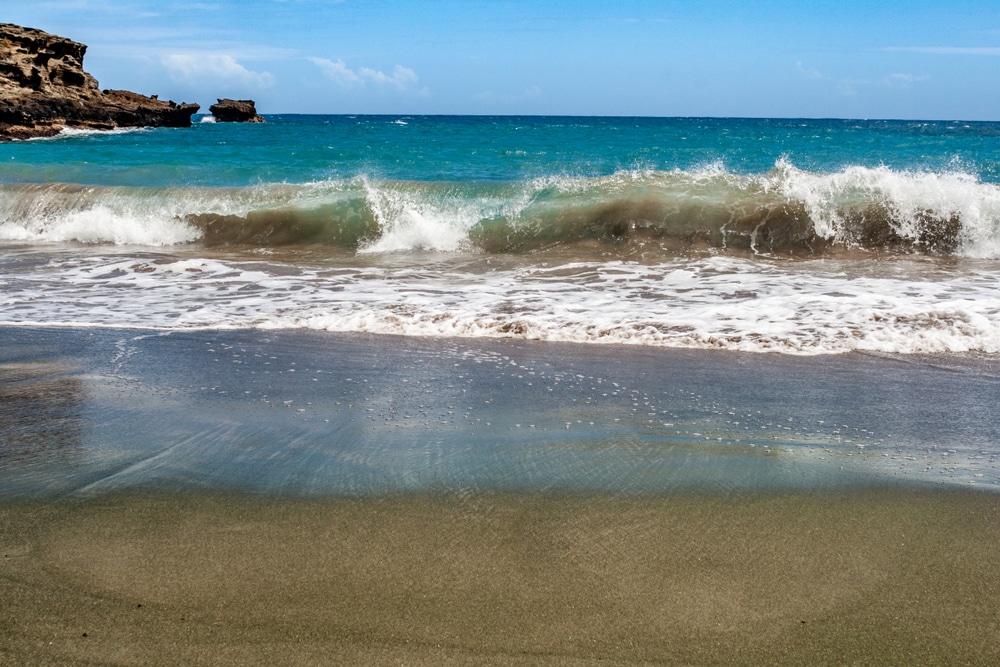
The Big Island of Hawaii’s Kaʻū area is the largest and most southern point in the United States. It is one of the least populated and least visited areas with breathtaking, wild scenery that is both remarkable and diversified. Couples, in particular, will experience no shortage of things to do and sights to see together.
Kaʻū is home to many of the island’s most sought-after attractions, including the following:
- Punaluʻu Black Sand Beach: The most well-known black sand beach in Hawaii is Punalu’u Beach. The beautiful black sand beach and the frequent sightings of green sea turtles and endangered Hawksbill turtles basking in the sun are two factors in this beach’s popularity.
For a good reason, this is the most well-liked black sand beach on the Big Island. Its brilliant mix of colors, including the green coconut palms, charcoal black sand, and shimmering blue waves, is something out of a fairy tale! - Papakōlea Green Sand Beach: One of just two green sand beaches in the country, green sand beach is one of the Big Island’s “once in a lifetime” destinations. An olive-colored beach was formed after a cinder cone erupted around 50,000 years ago due to the combination of the green olivine mineral and the black lava sand. It takes 1 hour and 2.5 miles from the parking lot to trek to Papakōlea. Although the surf can occasionally be rough, swimming in the bay is still an option. Bring extra food and water with you when you visit the beach because there are no lifeguards, facilities, or shops. Also, remember to take all of your trash with you.
- Hawai‘i Volcanoes National Park (Kahuku Unit): There are numerous day hike opportunities in this area of Hawai’i Volcanoes National Park. The park’s 116,000 acres of land are covered by about 20 miles of trails. The hiking trails offer various levels of difficulty and constantly shifting topography, and a small section is accessible for mountain biking. Additionally, a 9-mile scenic route that ascends the slopes of Mauna Loa by 1300 feet allows you to explore the park from your car.
But first, coffee! Coffee mills began sprouting up on the abandoned land in Kaʻū when the sugar cane plantations collapsed. Kaʻū Coffee Mill has provided tourists and residents with award-winning specialty, flavored, and artisanal coffee since May 2012. Begin or end your day with one of their free daily farm tours and sample some delicious coffee.
Budget-Friendly Areas on the Big Island
Hilo
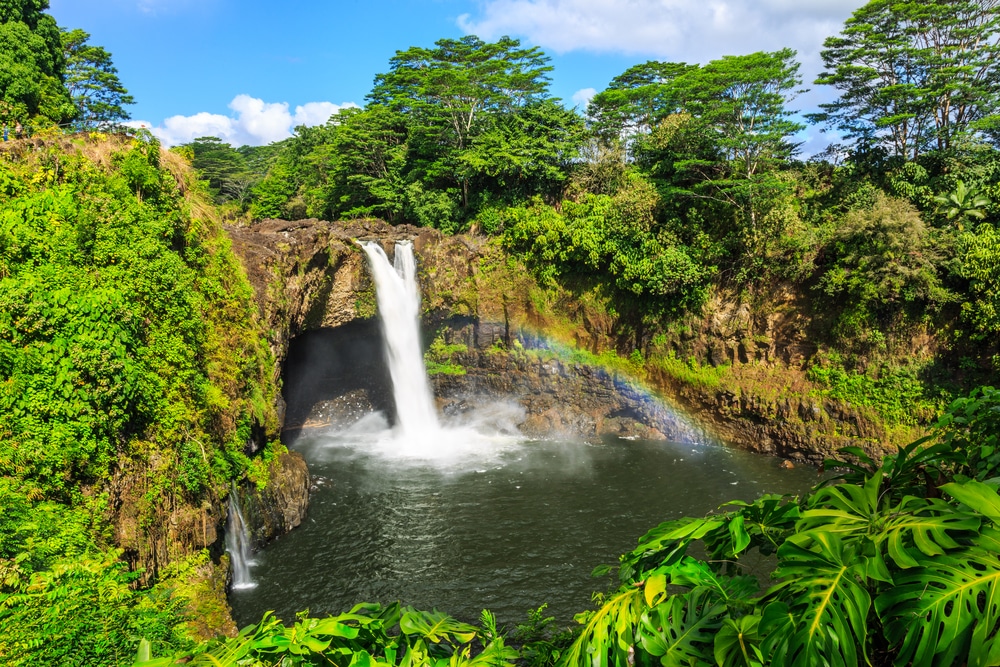
Hilo has a more local feel and offers breathtaking sights, including rainforests, national parks, and stunning beaches. Additionally, compared to other areas of the island, it sees less tourism. Because of this, you can find reasonably priced lodging here.
So, Hilo is one of the best areas to stay if you want to vacation on a tight budget!
Most people only stay in Hilo for a short duration of their vacation. Despite its proximity to the Volcanoes National Park and the Hamakua Coast, there are difficulties to consider.
On this side of the island, temperatures are typically a little cooler, and there is a lot more rain. It rains 127 inches on average every year, making it the fourth wettest city in America. Additionally, swimming and snorkeling can be dangerous because beaches are less protected.
With that said, there are plenty of activities for those that do decide to spend more than a day trip in the biggest town on the island’s windward side. For those seeking a little adventure on a budget, Hilo is a lure, thanks to its picturesque downtown and convenient access to some of the sights and attractions along its scenic coastline.
Hilo also boasts the best hiking paths with dramatic cliff views. You can explore lava fields, botanical gardens, and waterfalls in a single day. Additionally, you can fly directly to Hilo Airport if you’re flying between islands or from a few west coast locations.
Below are some of the must-see sights and attractions Hilo has to offer to the budget-friendly traveler:
- Coconut Island: Hawaiians refer to Coconut Island as Moku Ola, where Moku stands for “Island” and Ola for “Life.” Located close to Liliuokalani Gardens and only a short 250-foot bridge walk from Banyan Drive in Hilo, Coconut Island offers a unique experience and entertaining tour. You can easily spend a few hours or a full day relaxing on the island’s small beaches.
- Akatsuka Orchid Gardens: The Akatsuka Orchid Gardens, situated between Hilo and Volcano, showcase Hilo’s status as the world’s orchid capital. On a rainy day, take a short drive and stop here to enjoy an organized or guided tour of the numerous stunning tropical orchids.
- Don’t go chasing waterfalls, or, in this case, do: Rainbow Falls and ‘Akaka Falls are both easily accessible from Hilo. Rainbow Falls cascades down over a lava cave where the moon goddess Hina, an extinct Hawaiian deity, resides. Just a few miles north of Hilo is the Big Island’s most well-known waterfall, “Akaka Falls,” which is reachable by a beautiful, quick climb to the 422-foot tall falls.
Waikui
The Big Island’s bright hillside section along Highway 19 in the northwest is known as Waikui. This region is close to the coveted dry side of Waimea and borders the picturesque Kohala mountain range.
Homes are conveniently accessible to the town, as well as some of the best white sand beaches and resort locations on the west side. Additionally, a short drive will take you to the Kohala Coast, where you can laze the day away on one of the gorgeous beaches, do some shopping, and dine oceanside.
Waikui often experiences sunshine, stunning sunsets, ocean views, and less rainfall. On clear days, one can occasionally see the islands of Maui and Lanai. Fishermen and watersports fans will value Waikui’s proximity to boat harbors and its ocean access.
It doesn’t get more budget-friendly than Waikui’s below attractions:
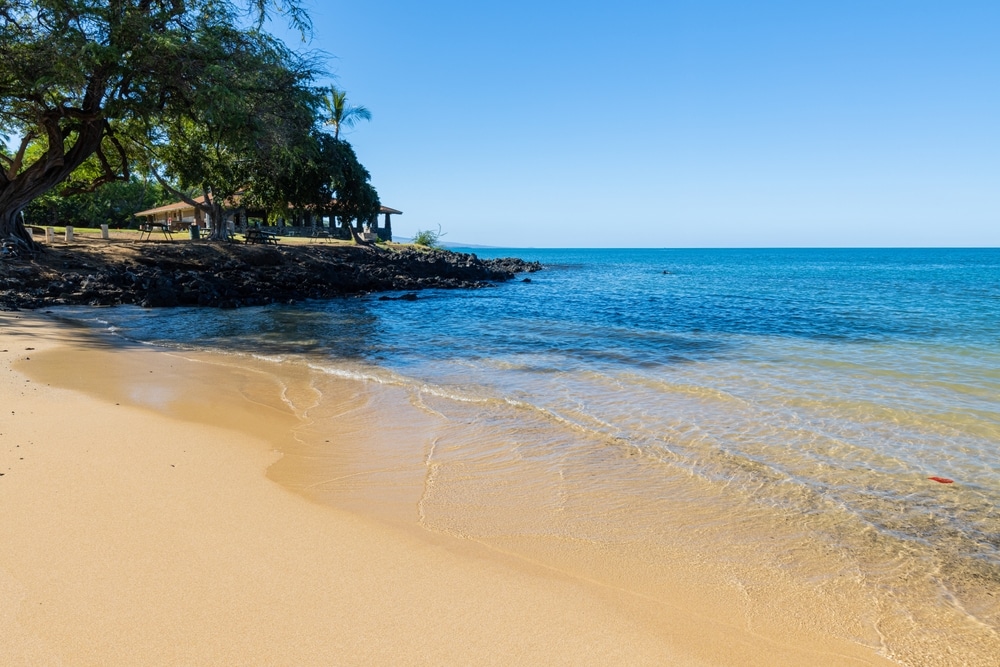
- Spencer Beach Park: Fancy a once-in-a-lifetime beachfront camping experience? Spencer Beach Park offers just that! The harbor landfill to the north and the long, shallow reef offshore provide good protection from the dominant winds and offshore waves. The park’s amenities, which include restrooms and showers, have made this protected beach a particularly popular destination, especially for families with young children.
- Pu’ukohola Heiau National Historic Site: Within walking distance to your campsite, you can check out historical sites, including the preserved ruins of the last significant Ancient Hawaiian temple.
Solo Traveler’s Getaway on the Big Island
Puna
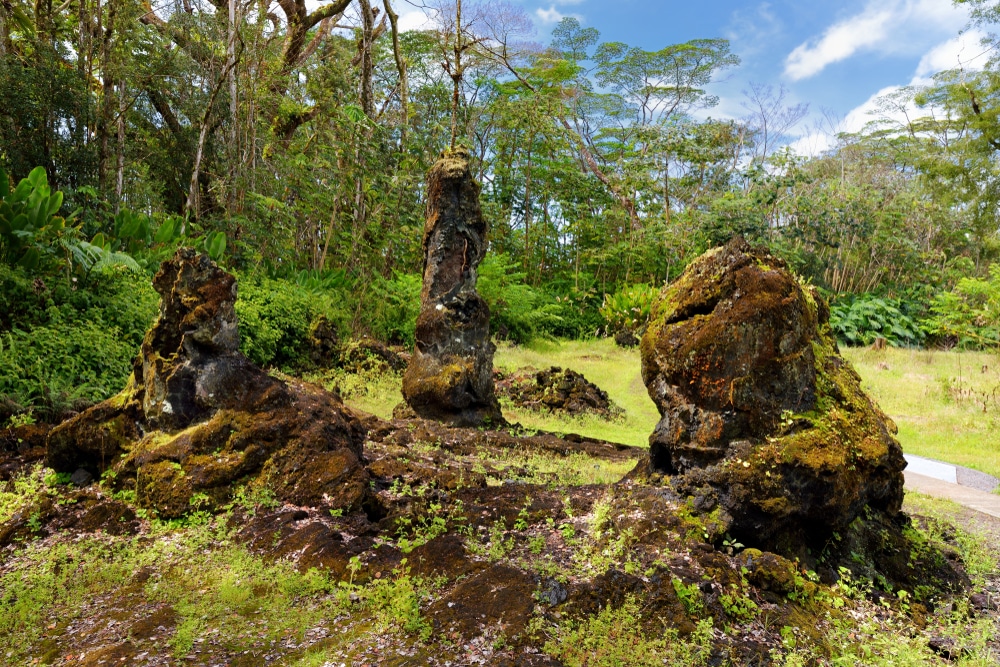
Puna, which sits directly across from Kona on the east side of the Big Island, offers extraordinary scenery, including the finest place to shoot amazing photos: Kehena Black Sand Beach.
The neighboring lava fields created this beach. Because spinner dolphins frequent the area, the beach has also been referred to as Dolphin Beach.
Continue on your solo journey after that to see rural Puna’s additional notable attractions:
- Lava Tree State Park and Monument: A lava flow that rushed over the woodland in 1790 gave rise to the forest of lava trees found at Lava Tree State Park and Monument. Casts of hardened lava developed around the tree trunks due to the lava’s contact with the cool, damp bark. The castings of these tree trunks remained after the first lava flow subsided, serving as a phantom memory of the impressive trees that once dominated the forest.
- Pāhoa: Often referred to as Hawaii’s “outlaw town,” Pāhoa entices locals and visitors alike. This funky, bohemian village features western-style storefronts, run-down buildings painted bright colors, wooden boardwalks, vintage shops, and a fantastic dining scene, including the beloved Pāhoa fresh fish.
- New Kaimu Black Sand Beach: The old Kaimu Beach was covered in 50–70 feet of lava in 1990 when a river of lava flowing from the volcano reached the shoreline. Kalapana, the entire community, and other neighborhoods in its fiery, molten path, were also destroyed. A cascade of lava streamed into the ocean for several months, igniting the birth of new land as the lava filled the bay next to the shore. Today, New Kaimu Beach is a beautiful, albeit unsettling, landscape, especially in the late afternoon light just before dusk.
After a memorable day exploring, you can enjoy a fantastic meal at one of the neighborhood eateries in Puna’s town center. While there are lovely accommodations where you’ll enjoy being in nature, you won’t find any large resorts in Puna.
Volcano
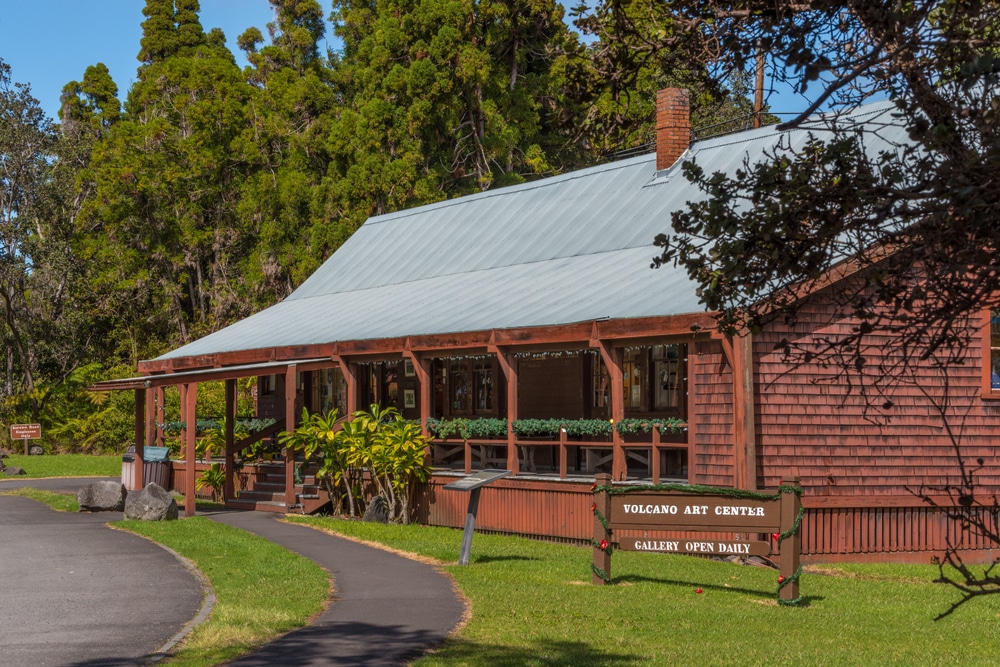
If seclusion and out-of-this-world terrain are what you seek, then Volcano is where to stay on the Big Island. This region is as jungle as it gets, as lush, dense rainforest gives way to incredible swaths of lava rock.
The tiny community of Volcano, located just outside Hawaii Volcanoes National Park‘s entrance, serves as a sort of basecamp for park adventures. Exploring the park could be done on a day trip, but it’s such a significant activity that it could easily take a few days if you’re really into it.
Volcanoes National Park is huge. The most well-known site is the Kilauea volcano, which displays much evidence of volcanic activity, including gorgeous calderas, hot steam vents, and slow lava flows. Though Kilauea is sometimes mockingly referred to as a “drive-in” volcano, the park is home to miles and miles of hiking paths. Hike and camp along the untamed south shore of the Big Island as Volcano becomes your idea of a paradise away from home.
Even though Volcano village is small, it has a lot of appeal despite its somewhat rustic appearance. It is a well-liked area for artists who contributed to its eccentric culture. In addition to Volcano’s main attraction, be sure to check out the below for a glimpse of a locals’ life that is well-suited for the adventurous solo traveler:
- Volcano Village Farmer’s Market: The “social event of the week” in Volcano is the farmers market in Volcano Village. Many islanders go out to meet friends, exchange news, and listen to the “coconut wireless,” otherwise known as the Big Island gossip. Suppose you are staying in Volcano Village for the weekend. In that case, you can start your Sunday early by going to this market to buy souvenirs to take home and food for lunch before exploring Volcanoes National Park.
- Volcano Winery: Since 1993, the only winery on the Big Island has been making award-winning, distinctive wine. Volcano Winery is one of the island’s best-kept secrets, rapidly growing to be a favorite destination for tourists from all over the world. Nestled between Mauna Loa and Kilauea, their wines are only available in the Hawaiian Islands.
- Volcano Art Center Gallery: Volcano Art Center is housed in the historic 1877 Volcano House Hotel in Hawaii Volcanoes National Park and runs following a cooperative arrangement with the National Park Service. Since 1974, the Kilauea-based Volcano Art Center Gallery has been a hotspot for visual artists.
Where Will You Stay on the Big Island?
Now that you know the best areas to stay for a family vacation, a romantic getaway, a budget-friendly trip, or a solo trip, you’re ready to plan your trip to the Big Island of Hawaii. With so much to see and do on this incredible island, we’re sure you’re going to love it!
Featured Image Credit: Maridav
